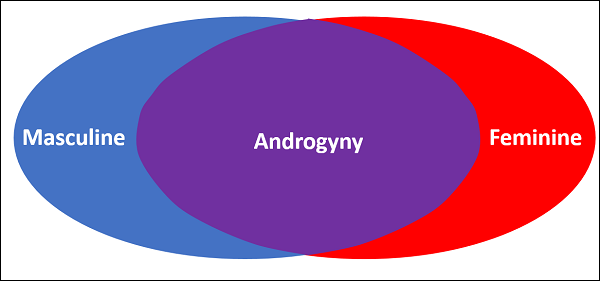Module III: DiversitySection 2: GenderAfter completing this section, students should be able to:
Throughout our lives there is one "intercultural" experience we have virtually every day; interaction with the opposite sex. Stereotypically, men complain about women talking too much, and women complain about men not talking enough. While there are many stereotypes and assumptions about how men and women communicate differently, there is growing acknowledgement that there are communication styles that are more feminine and communication styles that are more masculine.
It is important to clarify that sex and gender are not synonymous. Sex is biological; it is the set of physical parts you have that identify you as male or female. The vast majority of us are born with clearly defined sexual organs, yet according to Brown University researcher Anne Fausto-Sterling, about 4% of babies are born with some form of indefinite sex identification (Fausto-Sterling, 1993). These children, known as intersex, may be born with genitalia that, because of the small size at birth, cannot be clearly differentiated between a clitoris and a penis. Intersex persons face special challenges, especially if the parents and/or doctors decide to artificially determine the baby’s sex surgically instead of waiting to see how the child develops naturally. As puberty hits, these children will hormonally develop as they are genetically determined, and if the surgical choice was incorrect, enormous personal difficulties can result.
Gender, on the other hand, is a social construct. Genetics determines sex; cultures determine gender. What it means to be male or female within a given society is developed within that society. Boys are taught what it means to be a man; and girls are taught what it means to be a woman. We teach children how to act, think, and live within these social constructs. We give little girls nurturing toys, such as dolls, and we give little boys aggressive toys, such as guns. Girls are rewarded for cooperating and getting along, while boys are rewarded for competing and winning. Consider the range of sources that influence and reinforce these gender constructs. Family, friends, media, school, religion, and other such cultural institutions all communicate messages of male and female roles, often contradictory to each other. While a family may encourage a little boy to pursue his interests regardless of traditional male roles, his friends may pressure him in other directions. Gender is not static; it can change over time. In the last 50 years in the U.S., gender has changed quite dramatically, from the highly traditional, rigid expectations of the 1950s and 1960s to the more equitable and fluid present-day expectations. A young woman maturing in the 1950s would have been expected to marry, usually right out of high school, and be a stay-at-home mother, tending to the children, home, and her husband. If she was to work outside the home, it would typically have been in a limited number of “caring” professions such as teaching and nursing, or in low-paying service roles, such as housekeeping. Today, while a woman can certainly choose to be a stay-at-home mother, she is also free to choose virtually any other path she desires. Likewise, the rigid expectations of men as the sole family provider, expected to earn more than his wife, have eased significantly. The social constructs of gender will evolve as the culture evolves. We also need to consider sexual orientation. Sexual orientation simply refers to what attracts a person sexually. Heterosexual means to be attracted to the opposite sex, and homosexual means to be attracted to the same sex. There are bisexuals, who are attracted to both men and women, as well as asexuals, who do not really experience a sexual drive. According to the American Psychological Association, sexual orientation is a complex issue:
First, when discussing gender and communication, it is overly simplistic to say, “Men talk like…” or “Women talk like….” A far more accurate way to categorize these differences is as a masculine communication style and a feminine communication style. These terms address patterns of communication behaviors. Who uses which style to what degree is secondary to understanding the implications of which style they use.
Second, it is also very tempting to assume this discussion suggests all men communicate using a masculine communication style and all women communicate using a feminine communication style. This is simply inaccurate. Most of us are androgynous, having some traits from both communication styles, even if one is more dominant than the other. Depending on the setting and the other person, we tend to shift between the styles, using whichever is more comfortable and appropriate at the time. For example, communication instructors might hear from female students that their boyfriends/husbands will act so differently around his male friends than when with her. When in a mainly male environment, he will tend to move further into a typical masculine communication style, yet with her, he will take on more feminine communication traits. He moves between the communication styles to best fit the dynamics of the situation. Male students might make a similar statement about their girlfriends/wives. Third, it is also tempting to connect communication style and sexual orientation. There is no connection. Current research suggests communication style is a blend of nature (your genetic makeup) and nurture (how you learn to communicate). Environment plays an enormous role in developing your communication style. We model those around us, especially significant caregivers and those in our reference groups (see Tannen, 1990; Brizendine, 2006; Brizendine, 2010). Fourth, there has been some suggestion the feminine style is better than the masculine style. This is also an erroneous assumption. These are simply different communication styles, each with strengths and weaknesses, and we need to be aware of those differences in order to adapt and improve our ability to work within this range of styles. There are times a highly masculine style fits the situation best, and times a highly feminine style works better.
Perception and Emphasis The masculine style and feminine styles focus on the world differently. Within our American culture, the masculine focuses on independence and autonomy, and the feminine focuses on interdependence and relationships. American males learn the ability to succeed and prevail by oneself is a powerful goal. Boys are more often encouraged to play competitively, placing a clear emphasis on winning and losing (Tannen, 1990). Women often joke about men not being willing to ask for directions, but consider what this masculine style suggests. When he stops to ask for directions, he is admitting a degree of failure. He has not been able to solve the problem. He has, in effect, lost. Something breaks around the house, and he may immediately dive in, regardless of his actual knowledge and ability level, reluctant to call a repairperson, working hard to solve the problem himself. The masculine style values self-reliance and the ability to fix things so highly that to violate the standard may be extremely difficult for many. As a result of this drive for independence and autonomy, and since the masculine style puts a lower value on seeking assistance, those using the masculine style tend to not want to talk about issues and problems until after they have been processed and solved. John Gray (1992), author of Men are From Mars, Women are From Venus, describes how a man will retreat into his mental cave to ruminate and process the problem, and once the solution is determined, he emerges to share it. Deborah Tannen (1990), author of You Just Don’t Understand, describes this form of communication as report talk:
The feminine, on the other hand, places a high value on creating and maintaining connections among individuals. Problem solving is accomplished by interaction and conversation, not by retreating and ruminating. While the masculine values individual problem solving, the feminine values collective problem solving. While he goes to the “cave,” she goes to the “coffee shop,” seeking companionship and support as she works through life’s issues. Tannen refers to this form of communication as rapport talk:
For the feminine style, conversation can by itself be the solution. The reaffirmation of relationships is of high value and a worthy goal in its own right. Since interdependence and connection is paramount for the feminine, decision-making is a collective process. While the masculine style favors quick, immediate decisions, the feminine style favors decisions that are processed among the affected individuals, finding the best solution for all parties involved. Maintaining the relationship is quite important for the feminine communication style, while for the masculine the effectiveness of the solution is paramount, regardless of its impact on relationships. Differences in Masculine and Feminine Communication As you review the chart below, keep in mind most of us are androgynous, and we use a blend of masculine and feminine communication styles, adjusting our communication behaviors to fit the situation. Clearly, the masculine and feminine styles are different. However, in the overall picture of human communication, our similarities far outweigh our differences. As effective communicators, our goal is to recognize, respect, and adapt to differences. Instead of letting differences interfere with clear communication, we acknowledge them and adapt to them. When Keith's wife comes home from work, he knows sharing her day with him is her way to de-compress from work and to reconnect with him. Likewise, when she asks about his day, sharing some level of detail reciprocates the desire to connect. At times, however, she knows to leave him alone and then, once he has processed the issue confronting him, he will share the results. The harder she pushes him to talk, the more he retreats to his cave; she has learned to be patient and wait until he voluntarily re-emerges. When he comes out, he is ready to share the solution he has reached. Communication is complex enough, but as we factor in issues related to gender, the complexity increases. While our similarities in communication behaviors outweigh these differences, they nonetheless exist and have to be considered for increasing our communication effectiveness. Neither style is inherently better; both have their strengths and weaknesses.
The terms and concepts students should be familiar with from this section include: Differences in Masculine and Feminine Communication
American Psychological Association. (2008). Answers to your questions: For a better understanding of sexual orientation and homosexuality. Retrieved 3/28/13 from www.apa.org/topics/sorientation.pdf
Brizendine, L. (2006). The Female Brain. New York, NY: Broadway Books.
Brizendine, L. (2010). The Male Brain. New York, NY: Broadway Books.
Fausto-Sterling, A. (1993, March-April). The five sexes: why male and female are not enough. The Sciences, 20-24. Retrieved 3/28/13 from http://www.uta.edu/english/timothyr/Fausto-Sterling.pdf
Gray, J. (1992). Men are From Mars, Women are From Venus. New York, NY: Harper Collins Publishers
Tannen, D. (1990). You just don’t understand. New York, NY: Quill.
| |||||||||||||
|
|||||||||||||




